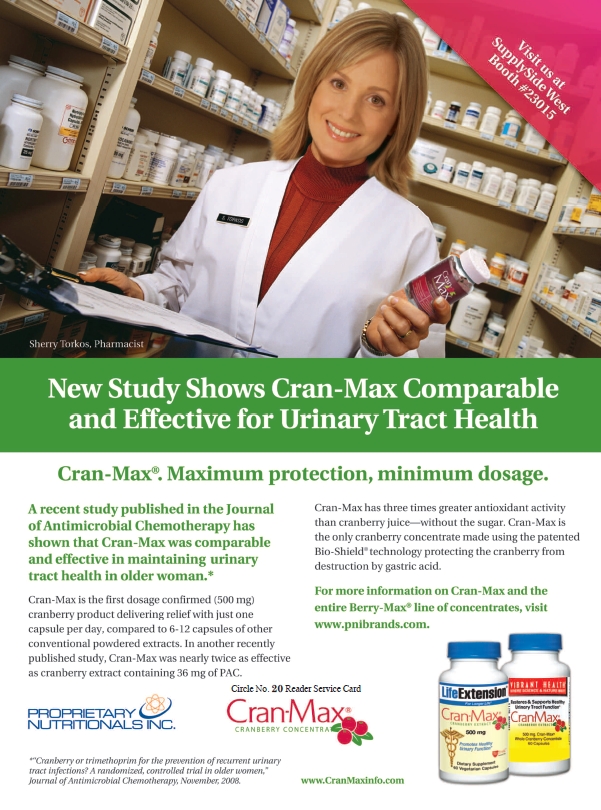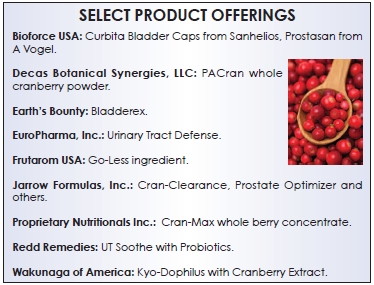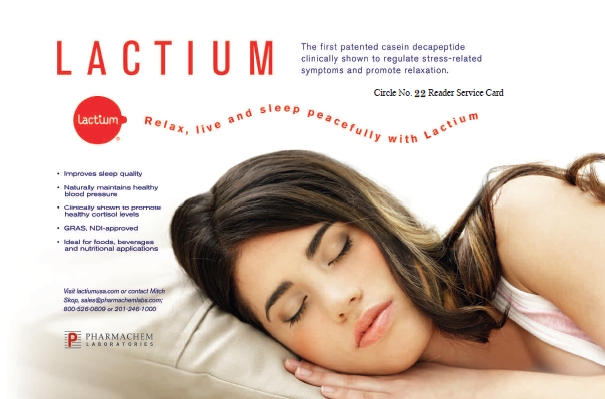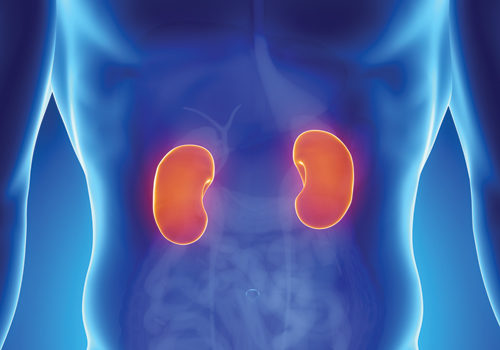Despite shoppers’ openness with many health topics, some are still very taboo. The list of “hush-hush” issues frequently includes urinary problems, which often are only discussed in whispers with close confidants.
Given this backdrop, retailers must have what it takes to talk knowlegably, confidently and sympathetically about these sensitive topics. Most important, they should alert concerned shoppers that certain dietary and supplementation choices help keep the urinary tract in tiptop working condition.
Not Set in Stone
About 10% of Americans get a kidney stone at some point in their lives (1). Stones develop from crystals that separate from the urine, which normally would contain chemicals that prevent them from forming in the first place (2). But sometimes, the urine doesn’t create the right atmosphere to do this, and stones are formed.
While there’s no sure method of eliminating future kidney stones, there is general consensus that diet can help—or hurt—the situation. “Contributing foods and ingredients include high-fructose corn syrup, soda, apple juice, fluoridated water, other refined sugars and animal protein,” says Cheryl Myers, head of education and scientific affairs at EuroPharma, Inc., Green Bay, WI. “Just about any fast-food meal is a sure ticket to kidney stones. Combine that with the fact that most people don’t hydrate enough during the day, and you have a ‘perfect storm’ of conditions.”
To better understand the role of diet, Dean  Mosca, president of Proprietary Nutritionals Inc., Kearny, NJ starts us off by explaining, “not all kidney stones are created equal.” Physicians often look at the shape and composition of a stone to understand a patient’s condition and which foods are a place to start for prevention.
Mosca, president of Proprietary Nutritionals Inc., Kearny, NJ starts us off by explaining, “not all kidney stones are created equal.” Physicians often look at the shape and composition of a stone to understand a patient’s condition and which foods are a place to start for prevention.
For instance, kidney stones most commonly contain calcium, particularly calcium oxalate; this type of stone typically forms when urine is too acidic (low pH) (2). Factors contributing to urine’s over-acidicity include eating high-oxalate foods (2). Patients prone to this kidney stone may want to avoid beets, spinach and rhubarb, even though others may benefit from some of these high-potassium foods.
These folks may also want to limit salt intake since high-sodium diets may be linked to calcium excretion in the urine. Mosca explains, “When the kidneys excrete sodium, it causes more calcium to be excreted in urine; higher levels of calcium in the urine may combine with oxalate and phosphorus to build a stone.”
Calcium may be on the “avoid list” for some people, too. In addition, people who have calcium metabolism dysfunction often develop kidney stones.
At the same time, dairy products may help some kidney stone sufferers. Take uric acid stones, for instance, which form for a similar reason (i.e., persistently acidic urine). States Neil E. Levin, CCN, DANLA, nutrition education manager at NOW Foods, Bloomingdale, IL, “Dairy products have been shown to lower the risk of uric acid stones.” This may be because dairy products bind to oxalate, so it isn’t absorbed into the bloodstream and, thus, urinary oxalate levels are reduced. But, this effect was found in a study to not be linked with supplemental calcium (3).
Other dietary considerations for this group could include animal proteins, “notably purines, which are abundant in organ meats, shellfish and fish,” states Mosca. The reason why is that the body breaks down protein into uric acid, which can increase the risk of uric acid stones. Plus, red meat lovers will want to know that these foods lower urinary pH, another risk factor for developing uric acid stones (3).
Given that pH—either too high or too low—affects kidney stone formation, those prone to stones should carefully consider their beverage choices. “The first rule is to drink plenty of fluids,” says Levin.
Water is a great choice, but other liquids like grapefruit juice and dark colas may aggravate the problem. Jay Levy, director of sales at Wakunaga of America Co., Ltd., Mission Viejo, CA, says caffeinated beverages could be especially problematic. “When investigators gave people with a history of kidney stones a dose of caffeine equivalent to that found in two cups of coffee, they began to excrete more calcium in their urine, putting them at increased risk of forming kidney stones,” he states.
 Cranberry juice may be an issue for those with calcium oxalate stones. But, retailers can check with manufacturers (and patients with their doctors) about whether supplemental cranberry juice extract is off limits. Mosca, for one, says his company’s extract isn’t a source of oxalates. He states, “While the National Institutes of Health warns against cranberry juice due to oxalates, we encourage consumers concerned about developing kidney stones to support their urogenital health through cranberry supplementation.”
Cranberry juice may be an issue for those with calcium oxalate stones. But, retailers can check with manufacturers (and patients with their doctors) about whether supplemental cranberry juice extract is off limits. Mosca, for one, says his company’s extract isn’t a source of oxalates. He states, “While the National Institutes of Health warns against cranberry juice due to oxalates, we encourage consumers concerned about developing kidney stones to support their urogenital health through cranberry supplementation.”
With a physician’s approval, other supplements may be important for those affected by oxalic acid stones, since raised levels of serum oxalic acid could indicate a functional deficiency of calcium co-factors magnesium, vitamin D and/or vitamin B6, according to Levin. Remember, these elements help metabolize calcium and deficiencies could result in extra circulating calcium.
For those with calcium oxalate issues, DHA/EPA may be a good addition to the diet. According to Levy, “A 2011 study that appeared in the Journal of Urology found that supplementing with fish oil for 30 days decreased calcium oxalate levels by 23%, thus reducing the risk of crystallization (4).”
As for vitamin C supplementation, there’s conflicting advice on the topic. States Levin, “Conventional wisdom says that high-dose vitamin C supplements (over 2,000 mg daily) raise the risk of uric acid stones, but that research is questionable and not accepted by many practitioners who utilize the vitamin in their therapies.”
This isn’t the only point of contention. Dallas Clouatre, Ph.D., R&D consultant for Jarrow Formulas, Inc., Los Angeles, CA, talks about varying opinions on drinking tea as an example. He says a Loyola University study indicated iced tea drinkers are more likely to develop stones than hot tea drinkers. “The explanation was that tea contains oxalates and people can drink a larger volume of iced tea than hot tea,” he states.
But at the other end of the spectrum, a 1998  Boston study found “the risk for stone formation decreased for each 8-oz daily serving of the following: 10% for caffeinated coffee, 9% for decaffeinated coffee, 8% for tea, and 59% for wine (5).”
Boston study found “the risk for stone formation decreased for each 8-oz daily serving of the following: 10% for caffeinated coffee, 9% for decaffeinated coffee, 8% for tea, and 59% for wine (5).”
Clouatre adds that there’s a lot to think about with dietary recommendations. For instance, he suggests the sugar in iced tea may be the problem, not the tea itself: “In one study in women, a diet with high levels of sugar intake increased stone formation by more than 30%.”
In the end, shoppers will have to work out the best program with their doctors since individual pH balances vary widely. Even one’s gender and age factors into the equation. Says Clouatre, “In men, a high intake of magnesium and potassium can reduce risk between 29 and 46%, but neither dietary nor supplemental calcium exhibits a significant association with kidney stone formation in older men, although dietary calcium intake is associated with reduced risk in those under the age of 60 (6).”
Kidney function. In many ways, this discussion of kidney stones relates to kidney function in general. In a nutshell, dehydration and infection could damage the kidneys. But, some of the most common offenders are excessive sodium and sugar intake, which will harm the kidneys over time since diabetes and high blood pressure are common causes of kidney failure, says Levin.
Citing the National Kidney Foundation (US), Clouatre says, “two-thirds of all cases of chronic kidney disease are related to these two conditions alone…Hence, the best approach to avoiding renal problems is to avoid diabetes, weight problems and hypertension. It is that simple.”
UTIs: Cranberry Extract and Beyond
Urinary tract infections (UTIs) are another extremely common ailment, especially in women. Though they are usually not a major health dilemma, infections cause varying degrees of discomfort and they tend to recur in some form.
“Urinary tract infections are a big health concern,” says Myers. “Almost 20% of women who have a urinary tract infection will likely have another, and 30% of that group will have yet another UTI. In fact, of that 30%, 80% of women will have recurrences. For some women, these infections can occur several times a year.”
Happily bogged down. Much new research has investigated natural remedies’ effect on UTIs and bladder infections. Some of the most compelling new studies center on—you guessed it!—cranberry extract.
Cranberry has such convincing support for urinary health that one natural product (Cranberry-Active, a cranberry capsule from Decas Botanical Synergies) is a registered Class IIa medical device.
States Dan Souza, senior director of sales and marketing of Decas Botanical Synergies, LLC, Carver, MA, “It is the only cranberry-based product in the world that can market a Treats and Prevents medical claim. Decas has invested heavily into the development of PACran, the cranberry ingredient in Cranberry-Active. Our leading-edge science provides the substantiation necessary to support these claims.”
Researchers continue to dive into the mechanisms of action and the quantifiable effects of this tried-and-true remedy. In fact, Levin says studies on how cranberries and d-mannose (a sugar found in cranberries and blueberries) stop bacterial adhesion in the urinary tract are “perhaps the most important research on the role of dietary factors against UTIs.” These ingredients stop bacterial colony-forming units (CFUs) from making new biofilms in the urinary tract, possibly by affecting the hydrophobicity of the bacterial cell surfaces. High hydrophobicity tends to coincide with enhanced adhesion.
Before proceeding, it must be emphasized that cranberry extract cannot claim to treat a condition like a UTI. Nonetheless, some interesting clinical trials pitted the extract against antibiotics and generated some impressive results.
Researchers collected data on 137 older women that had at least two antibiotic-treated UTIs in the past year. They either took 500 mg of cranberry extract (Cran-Max from PNI) or 100 mg of trimethoprim for six months. In the end, the antibiotic did only a marginally better job at protecting against future UTIs than the natural extract (7).
Other interesting research has focused on efficacy. Mosca speaks of a 2012 meta-analysis in which the authors compared a placebo to cranberry and concluded “consumption of cranberry-containing products may protect against UTIs in certain populations” (8).
Levy speaks of a 2010 placebo-controlled study that followed 24 women for two weeks: “Researchers found that those taking a cranberry extract had significant reductions in the amount of bacteria that attached to the urinary tract walls. No such benefit was seen in the urine of those taking the placebo (9).”
Myers feels cranberry extract is especially beneficial when paired with hibiscus extract. On its own, hibiscus was found in a six-month study to cut UTI incidence by 77% (10). Says Myers, “The study included 90 women from 18 to 55 years old having more than eight episodes of urinary tract infections per year, so these were serious cases…that meant the average woman went from about four infections in that time period down to one—or in some cases, none.”
She adds that hibiscus helps the urinary tract for a similar reason as cranberry: it inhibits the adhesion of E. coli (the bacteria that causes most UTIs). Myers notes that hibiscus is comprised of polyphenols, flavonoids, anthocyanins and chlorogenic acids, which “possess excellent antimicrobial activity against Staphylococcus, Bacillus subtilis and Pseudomonas aeruginosa as well as E. coli. In fact, the activity of these natural compounds is similar to the antibacterial drug, chloramphenicol, but without the serious side effects (11).”
It should be noted that berries other than cranberries also have anthocyanins that help prevent bacteria from colonizing the urinary tract and bladder. These include raspberries, blueberries and others.
Probiotics and UTIs. The UTIs story isn’t limited to just berries. Dan Chapman, CEO and founder of Redd Remedies, Bradley, IL, is most impressed with research into the effect of probiotics as well as their effect combined with anthocyanins from cranberries and other berries on UTIs.
“Recent research on probiotics for UTIs and other infections have shown that the beneficial bacteria in the gut have a definite positive influence on entire body ecology,” he states. “Probiotics have shown benefit in both preventative and therapeutic platforms.”
According to Levy, probiotics may help in two ways. “First, they prevent bacteria from adhering to the lining of the urinary tract. Second, by populating the urinary tract with beneficial bacteria, harmful pathogens are unable to thrive and trigger an infection,” he says.
Levin adds more details to Levy’s point. While they aren’t antibiotics, probiotics may “crowd out” the undesirable organisms, interfere with their attachment in the urinary tract, reduce excessive pro-inflammatory responses and more. “Of course, these are not antibiotics that are a quick cure for such infections; though antibiotics also tend to create additional health challenges due to their depletion of probiotics,” he states.
Clouatre says some researchers feel using probiotics for this purpose may be a better option for those who must constantly take antibiotics to treat and prevent UTIs. “While it is not the case that probiotics, such as Lactobacillus rhamnosus GR-1 and Lactobacillus reuteri RC-14 given twice daily, are equal in protection to chronic antibiotic use, in one large trial these probiotics cut UTIs by 51% compared with the occurrences of the preceding year and this compared favorably to the 59% improvement found with the use of antibiotics (12).”
Immediate need. While supplements aren’t treating infections, evidence suggests some supplements are appropriate for those that need support quickly. This group includes synergistic herbal combinations such as one formula that combines desmodium leaves, corn silk, abrus root, Herba pyrosiee leaves and Smilax glabra root.
“If you have a specific need, cranberry is great for its anti-adhesion benefits,” says Steven Kravitz, president of Earth’s Bounty and Matrix Health Products, Vancouver, WA. “However, if you have an immediate need, you’re going to feel up to 50% better in 48 hours with Bladderex.” He says the formula helps stop the loop of repeated problems, and incidences become further apart.
Bladder Benefits
The embarrassment of having an overactive bladder could perhaps rival any other urinary-related condition. While these feelings are natural, shoppers should know that this problem is very common and supplements can do a lot to support healthy bladder function. Such remedies can make a world of difference to those needing this support. “The positive impact of lessening micturition (both during the day, and at night when it constantly disrupts sleep) on quality of life as the population ages cannot be underestimated,” says Jeff Lind, vice president of the health business unit, Frutarom USA, North Bergen, NJ.
Overactive bladder (OAB) can be triggered by numerous factors. States Eileen Sheets, managing director of Bioforce USA, Ghent, NY, “According to the Mayo Clinic, filling and emptying the bladder is a complex interplay of kidney function, nerve signals and muscle activity. A problem anywhere in the system can contribute to an overactive bladder.”
Levin explains that OAB can be linked to nerve damage caused by infections, dehydration, kidney/bladder stones, diabetes, heart disease, multiple sclerosis, Parkinson’s, being overweight (due to increased abdominal pressure) and multiple pregnancies. In addition, menopausal and postmenopausal women are often affected because decreased estrogen levels can weaken the pelvic floor muscles that support the bladder, states Sheets.
That doesn’t mean men are off the hook for OAB. Inflammation in the urinary tract caused by an enlarged prostate could result in OAB. “An enlarged prostate puts pressure on the urethra and causes urination and bladder problems, including getting up many times a night to urinate,” Sheets explains.
These examples illustrate that OAB “can be closely linked to shifts in hormonal balance” in some people, states Lind. Partly for this reason, herbal supplements are important aids in bladder support.
Lind explains that pumpkinseed and soybean germ extracts (EFLA940 Pumpkin Seed and SoyLife 40, found in his company’s Go-Less ingredient) “can help the body adapt by directly impacting the affected tissues and hormonal balance that are underlying causes of overactive bladder. In vivo and in vitro studies have confirmed the impact of this particular blend.” One study of 120 women, for instance, showed this proprietary ingredient decreased the average daily urination frequency by 27% (13).
Sheets notes there is a pumpkinseed oil monograph from the German Commission that suggests its use for irritable bladder and reducing the frequent urge to urinate.
Just how pumpkinseed oil supports the bladder isn’t 100% clear, but Sheets says Dr. Helmar Dörfler from the medical department at Börner GmbH suggests a possible mode of action. “It is thought the tocopherols play a regulating role at the neuro-muscular junction (where the nerves meet the muscles of the bladder). It seems to harmonize or smooth out the messages from the nerves to the bladder, reducing the irritability of the bladder. It is also believed the cucurbitin, a rare amino acid found in the pumpkinseed oil contributes to the known bladder strengthening effect,” states Sheets.
Levy suggests magnesium for bladder support. He mentions a study conducted at Louisiana State University in which 60 women with urge incontinence were either given 350 mg of magnesium twice a day or a placebo (14). He notes, “Twelve of 30 women in the magnesium group reported improvement in their bladder control after one month, compared with only five of 30 in the placebo group. Plus, compared with the placebo group, the magnesium group experienced significantly fewer episodes of urge incontinence, urinated less frequently and awakened fewer times at night.”
Given that an enlarged prostate can trigger OAB in men, saw palmetto can be part of the arsenal. Of course, shoppers should talk to a doctor first if they suspect a prostate problem. But with a doctor’s approval, Sheets explains why saw palmetto has such a long track record of supporting the urinary tract in men.
“Saw palmetto works by preventing the conversion of testostorone to dihydrotestosterone, a form of testosterone that contributes to the swelling of the prostate gland. It is also known that saw palmetto extracts alleviate edema, is anti-inflammatory and anti-androgenic,” Sheets states. She adds that the end result can be a more regular and less frequent urge to urinate, but an increased urinary flow as well. “It increases a man’s quality of life by reducing the urinary symptoms of BPH, providing a welcome respite from getting up often at night and always feeling the need to know where the nearest restroom is,” Sheets points out.
And, men also may be interested to know that cranberry extract has research backing its use for prostate health. A 2010 study showed daily intake of a branded ingredient (PACran from Decas Botanical Synergies) had a positive effect on some markers of prostate health. “This science shows that cranberry is not just for women’s health,” states Souza.
First, the ingredient was shown to improve post-void residual urine by 65%. This is noteworthy because an enlarged prostate makes it difficult for the bladder to completely empty. In addition, the study found a 32% reduction in prostate-specific antigen (PSA) levels without affecting total testosterone levels (15). PSA levels are used by physicians to screen men for prostate cancer. WF
References
1. S. Cribby, M. Taylor and G. Reid, “Vaginal Microbiota and the Use of Probiotics,” Interdisciplinary Perspectives on Infectious Diseases, Volume 2008 (2008), 9 pages.
2. K. Sigurdson, “GLA Every Day Keeps PMS Away,” Bioriginal, www.bioriginal.com/services/files/file_14.pdf, accessed Aug. 31, 2012.
3. March of Dimes, “Folic Acid Keeps You and Your Baby Healthy,” www.marchofdimes.com/pregnancy/folicacid_before.html, accessed Sept. 1, 2012.
4. Fairhaven Health, www.fairhavenhealth.com, accessed Sept. 1, 2012.
5. V. Colliver, “Marin Bread Cancer Linked to Vitamin D Receptor?” San Francisco Chronicle, posted Aug. 8, 2012, www.sfgate.com/health/article/Marin-breast-cancer-linked-to-vitamin-D-3770785.php, accessed Sept. 1, 2012.
6. S. Hatse, et al., “Vitamin D Status at Breast Cancer Diagnosis: Correlation with Tumor Characteristics, Disease Outcome, and Genetic Determinants of Vitamin D Insufficiency,” Carcinogenesis. 33 (7), 1319–1326 (2012).
7. R. Soares et al., “Maitake (D Fraction) Mushroom Extract Induces Apoptosis in Breast Cancer Cells by BAK-1 Gene Activation,” J. Med. Food. 14 (6), 563–572 (2011).
8. University of Delaware, “Soy and Menopause,” April 4, 2012, www.udel.edu/udaily/2012/apr/melby-soy-menopause-040412.html, accessed Sept. 1, 2012.
9. T. Izumi, et al., “Soy Isoflavone Aglycones Are Absorbed Faster and in Higher Amounts than Their Glucosides in Humans,” J. Nutr. 130 (7), 1695–1699 (2000).
10. “Black Cohosh,” http://ods.od.nih.gov/factsheets/BlackCohosh-HealthProfessional, accessed Sept. 1, 2012.
Published in WholeFoods Magazine, October 2012










